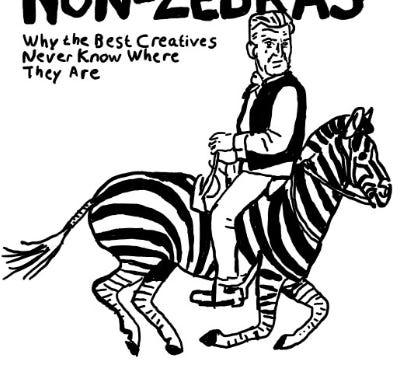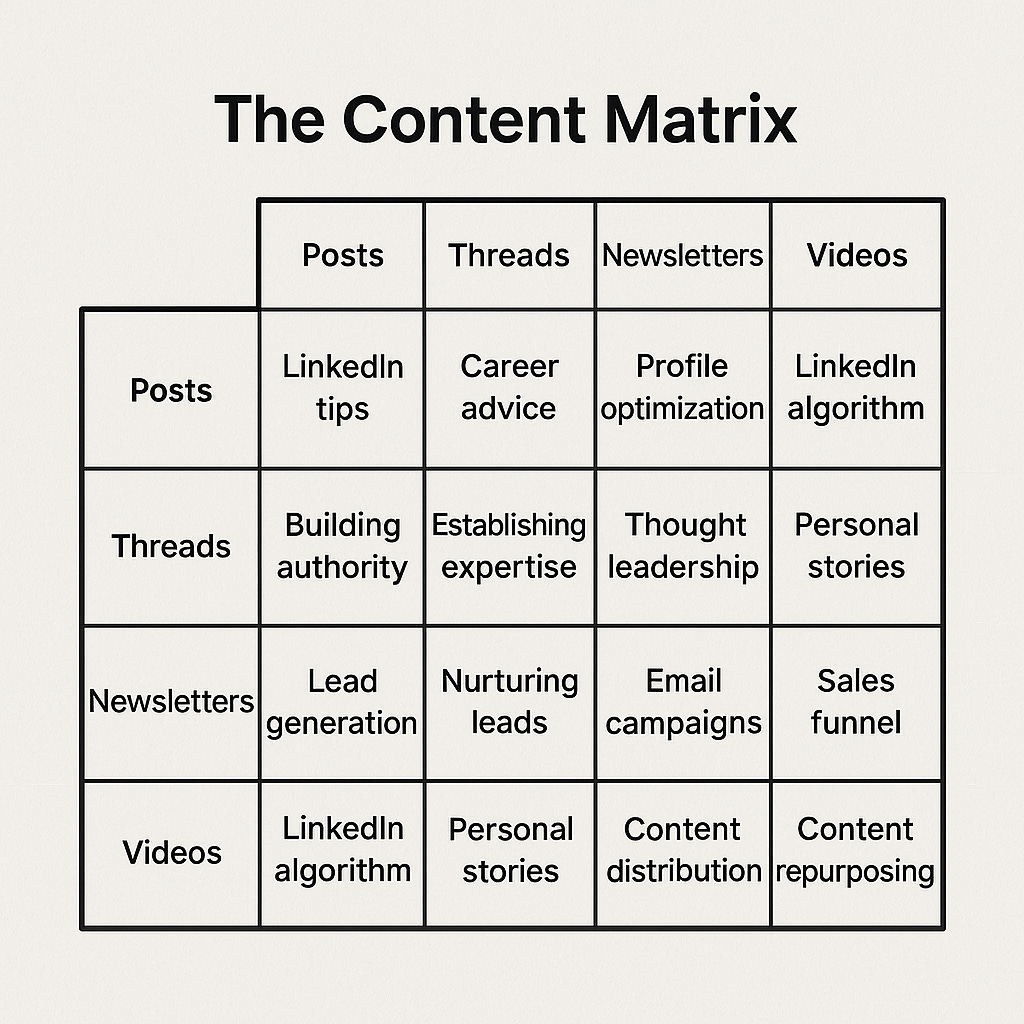Most people stare at a blank page and panic.
I used to be that person.
Sitting there… fingers hovering over the keyboard… mind completely blank.
It’s a special kind of torture that makes you question everything:
“Do I actually have anything valuable to say?”
“Has every good idea already been taken?”
“Why does everyone else seem to post so effortlessly?”
I wish I had an easy hack for you, but the brutal truth is that content creation isn’t about having more ideas than everyone else. It’s about having a system that generates ideas on demand.
Society has programmed you to believe creativity is some mystical talent bestowed upon the chosen few. That “creative types” just wake up with brilliant ideas flowing through their veins, while the rest of us mere mortals struggle.
That’s bullshit.
Creativity is a muscle. A system. A practice.
People are not born creative. The people who seem that way develop systems for creativity through various life experiences.
And I’m going to show you how to build that system.
In this letter, I want to discuss:
Why most creators struggle with generating ideas consistently
The psychological prison that keeps you idea-less and dependent
A proven framework for generating endless content ideas
How to build your own meta-creation system that works on demand
Why having a community of like-minded creators accelerates your growth
The one thing you can implement today to never face blank page syndrome again
The Mind Prison of the Idea-Less Creator
Let’s talk about the three reasons people struggle with content creation:
No time to write
Don’t know how to write
Don’t know what to write about
But here’s the thing.
It’s ALWAYS really just number 3.
The other two are just convenient excuses you make to mask the real problem:
You haven’t learned how to generate ideas consistently.
Most “content experts” will jump in here and tell you to:
- Follow trends
- Use AI prompt generators
- Copy what’s working for others
- Recycle old content
These are band-aids that create dependency, not solutions.
Idea Generator Frameworks
People think I was born creative. My ex-partner called me a unique content machine. He would also remind me that most people can’t do what I do. And I would remind him that we are all born with a creative nature. Creativity is what makes human beings human. The difference is that some of us grew up in environments that (for better or worse) worked that creative muscle, while others grew up in environments that atrophied.
The following systems and frameworks are the result of my reflection on what helped make me creative. At this point, they are all internalized and happen automatically. But I see no reason why adapting them and practicing them until they become internalized in yourself won’t help you do the same.
1. The Problem Collector
Start collecting problems like they’re rare Pokemon cards.
Every day, write down:
- Problems you personally face
- Problems your ideal audience mentions
- Problems you’ve solved in the past
- Problems your products/services solve
Problems are the currency of content creation.
Every great piece of content either identifies a problem people didn’t know they had or solves a problem they’re painfully aware of.
Create a “problem bank” in your notes app. I use Notion for this, but use whatever works for you.
Now when you sit down to create, you’ll have an arsenal of problems waiting to be addressed.
2. The Perspective Flip
This is where you take a common belief and flip it on its head.
What does everyone in your industry believe that might be wrong? What conventional wisdom have you tested and found lacking? What seemingly obvious “truth” is actually false?
The formula is simple:
“Everyone thinks X, but actually Y is true.”
Some examples:
Everyone thinks content creation requires inspiration, but it actually requires systems.
Everyone thinks you need a large audience to monetize, but you actually need the right audience.
Everyone thinks they lack creativity, but they actually lack frameworks.
This one technique alone can generate hundreds of content ideas.
3. The Experience Extractor
Your life is a gold mine of content ideas if you know how to extract them.
Think of every:
- Mistake you’ve made
- Success you’ve achieved
- System you’ve built
- Book you’ve read
- Conversation you’ve had
- Tool you’ve used
It can all be turned into valuable content.
The key is to extract the principle behind the experience.
If you learned to better manage your time by using a specific calendar app, the principle isn’t about the app...
It’s about creating boundaries, prioritizing effectively, or eliminating decision fatigue.
That principle can apply to countless situations your audience faces.
4. The Content Cube
Think of your content like a six-sided die:
The what (information)
The how (instruction)
The why (motivation)
The when (timing)
The who (identity)
The where (environment)
Every single topic can be approached from these six angles.
Let’s say your topic is “personal branding":
What: What elements make up a strong personal brand?
How: How do you consistently show up online?
Why: Why does having a personal brand matter now more than ever?
When: When should you pivot your personal brand?
Who: Who should you be targeting with your brand message?
Where: Where should you be focusing your brand-building efforts?
That’s six pieces of content from one topic.
The Meta-Creation System
Now that you have endless ideas, you need a system to capture, organize, and deploy them.
Here’s mine:
1. Capture Everywhere
Ideas come at unpredictable times. Create a frictionless capture system:
- Notes app on your phone
- Voice memos while driving
- Physical notebook by your bed
- AI or other second brain software
Don't get too worked up on the what. The medium doesn’t matter. What matters is that you have a system.
2. Daily Idea Sessions
Schedule 15 minutes every day to generate ideas.
Not to write content.
To generate ideas.
Treat yourself as an AI and use these prompts:
- What frustrated me today?
- What solution did I find useful today?
- What’s a belief I currently hold that might be wrong?
- What’s something people in my industry are ignoring?
- What’s a system I’ve built that others might find valuable?
Is this like journalising? Yes. But if I call it that, it will scare some of you.
Just do this daily, and you’ll have more ideas than you could ever use.
3. The Content Matrix
Create a simple matrix:
- Rows: Content types (posts, threads, newsletters, videos)
- Columns: Core topics you cover
Fill each intersection with ideas that fit both criteria.
For example, if one of your content types is “LinkedIn posts” and one of your core topics is “personal branding,” you’d fill that cell with ideas for LinkedIn posts about personal branding.
This gives your content structure and ensures you’re covering all the important ground.
4. The Idea Roulette
When all else fails, try this:
Take two unrelated concepts and force a connection between them.
Example pairs:
- Fitness + Marketing
- Psychology + Sales
- Gaming + Productivity
- Philosophy + Business
The magic happens in the connections you make between seemingly unrelated fields.
“What sales lessons can we learn from stoicism?”
“How is building a business like building muscle?”
“What can game design teach us about creating effective habits?”
This technique generates the most unique, attention-grabbing content ideas that no one else is talking about.
The Implementation Gap
Most people will read all of this and do nothing with it.
They’ll nod along, maybe save it, possibly even share it. But they, won’t implement it.
Don’t be like most people.
Start with one technique from this newsletter. Just one.
I’d recommend the Problem Collector.
Start right now.
Open your notes app and write down 10 problems you’ve recently solved or are currently facing.
That’s it.
Do that for a week and you’ll have 70 potential content ideas.
Still Need Help?
Let me be straight with you.
Most solutions to the content creation problem are garbage.
They promise you can “create content in just 10 minutes a day!” or give you recycled formats that were already annoying in 2022.
It’s bullshit, and it doesn’t work.
That’s why when I see a solution that actually addresses the real problem, I pay attention.
Attending one of my free upcoming masterclasses is one of those solutions.
Here’s what I teach…
The truth about why most content creation fails
The truth about the only two things you need to focus on before you start creating content
The truth about why you don’t need to build a personal brand, but how you need to become your own publicist.
No AI-generated nonsense. No recycled formats. No surface-level tactics.
Just practical, doable ideas that will make you better at LinkedIn or any social media platform if done right (plus someone telling you exactly how to do it right).
Or you can join my LIVE weekly Unforgettable Academy sessions, where for just $100 /month, you get access to me going very in-depth with particular lessons about what it takes to stand out online, as well as well as step-by-step guide to adapting each lesson to your voice and industry, and a community of people who are fighting the same blank page battle as you.
Is it worth $100 a month to never experience content block again?
— Justin (yes, this is really my email) Oberman
p.s All images in this newsletter were handrawn on a Remarkable Tablet and taken from my recent AdvertiZine, which can be read here








One of the writing tricks I love most is a weird AF analogy. Two things you’d never associate. It’s so fun to get philosophical over off the wall shit. It drives the point home in a way someone can actually process. Boom. New perspective born. Great article, Justin. 🌭
FYI--The link goes to your homepage and there are no free classes.